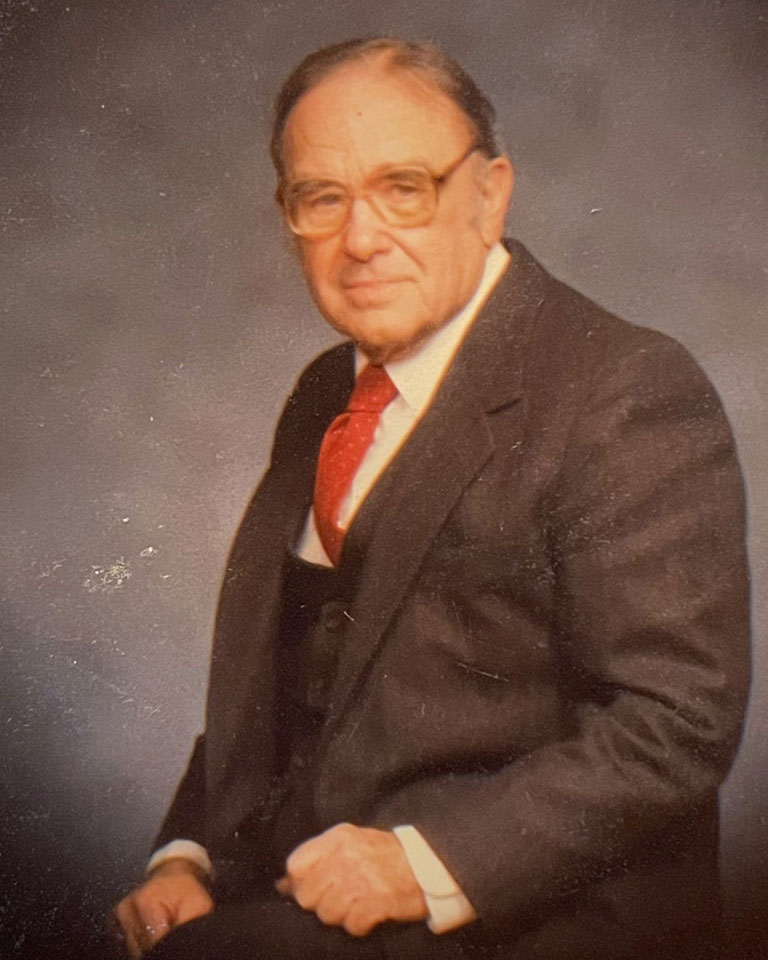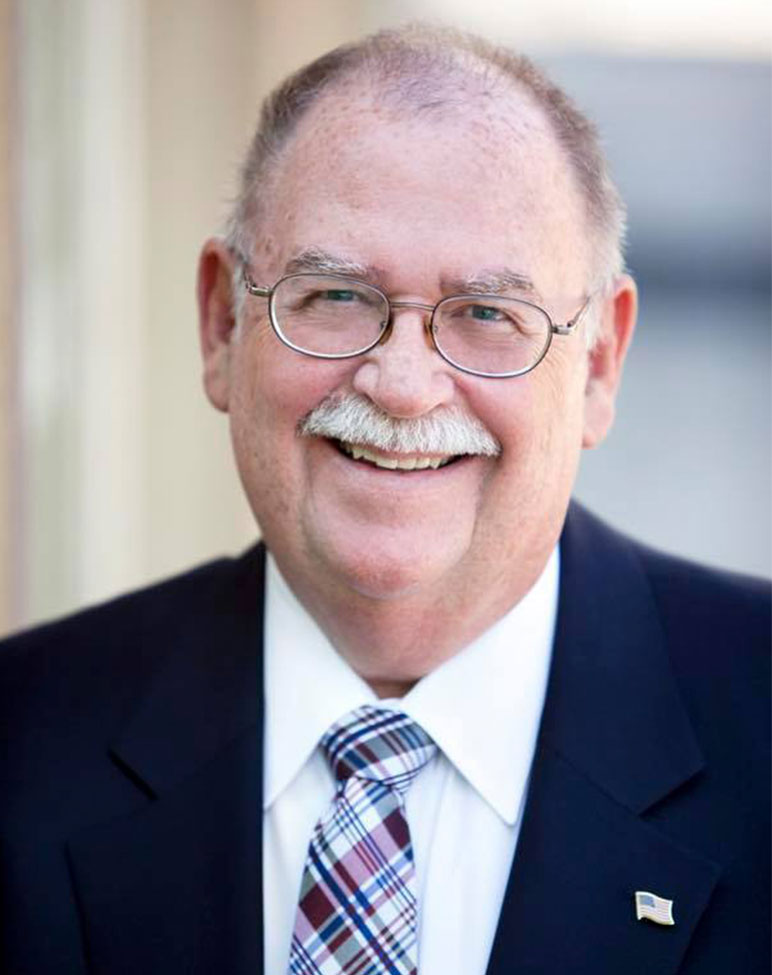2024 Legends of Lee's Summit
Mary Ann and Randy Rhoads and Ralph "Doc" Powell
Civic/Pioneer Category
In the early 1830’s, approximately a decade after Missouri became a state, two wagons joined the many pioneers in wagon trains traveling the trails established by Daniel Boone heading for Jackson County, Missouri. One wagon carried the family of Absalom Powell, Ralph Powell’s great-grandfather on his dad’s side; and the other wagon carried the family of William Harris, Ralph’s great-grandfather on his mother’s side. The families established farms that were among the oldest in Jackson County. Ralph’s ancestors raised crops, livestock and orchards of apples and often served as preachers. After Ralph’s great-grandmother Rhoda Harris was left a widow, she continued to run the farm, raise her fifteen children, serve as the area’s midwife, and grow medicinal plants in her backyard garden. Doctors were scarce during this period and sometimes these plants and medicinal remedies were all the early settlers had to help them treat illnesses and ease pain.




Two generations later, the two families merged when Prudence Harris married John Powell in the early 1900’s. Their son Ralph played on the Lee’s Summit High School football team which won the state championship during his junior year. He actually played football at the University of Missouri—all 5’ 5” of him—until he was tackled during a game, breaking several ribs and ending his short football career. Ralph graduated with an undergraduate degree in biology and a master’s in chemistry from Louisiana State University.
During the war years, Ralph did not serve in the military due to a medical deferment. Instead, he served as a civilian chemist for Monsanto in St. Louis, Missouri. In the early 1950’s, he returned to Lee’s Summit with his wife and young family, established his chiropractic practice and began serving his community. In 1955, he was elected to the Lee’s Summit City Council. At that time, Councilmen served as various commissioners—Police, Fire, Water, Streets and so on. Ralph served as the Water Commissioner. It’s hard to imagine not having water available to meet not only business but also household needs. At this time water use was frequently rationed and the acquisition of a consistent source of water was a major priority.
During Ralph’s tenure, Lee’s Summit entered into an agreement with Kansas City and Independence that ensured a steady supply. During his tenure, a new city hall was located in the old post office, and negotiations were made with Western Electric to build a new facility within Lee’s Summit’s city limits. This decision greatly affected the city’s growth pushing the somewhat sleepy small town to a thriving suburb. When Ralph was elected Mayor in 1964, he oversaw the application for over 14 infrastructure grants under Federal urban renewal programs. These led to new roads, additional parks, and the Lea Haven community center to mention a few. At this time, Lee’s Summit faced the challenge of urban sprawl. Cities and suburbs were expanding their boundaries. Through annexation, Lee’s Summit increased its land area to approximately what it is today, around 65 square miles. This annexation ensured that Lee’s Summit could grow for many years without the threat of being hemmed in by Kansas City or its suburban neighbors.
Mary Ann, Ralph’s youngest daughter, and her husband Randy moved back to Lee’s Summit in 1977 after college and early careers that had taken them outside the area. Mary Ann worked for the R-7 School District teaching special education. Randy worked as a Mechanical Engineer and Project Manager for Black and Veatch. Mary Ann’s career took a turn when she was asked to run the pilot program for the new Early Childhood Education program for the district. Mary Ann was also required to provide training for other school districts all over the state of Missouri. Mary Ann concluded her time with the R-7 district serving as a Special Education Process Coordinator.
Randy began his public service when Smokey Dyer, the Fire Chief at the time, asked him to serve on the Public Safety Advisory Board. From there, he ran and was elected to the city charter commission in 1995. In 1998, Randy was elected to the City Council and served for twelve years. In 2010, Randy ran for Mayor of Lee’s Summit. During Randy’s 20-year tenure as Councilman and Mayor, the population of Lee’s Summit grew to nearly 100,000 people. Many changes had to be made to meet the needs of this growth. A new Police Department headquarters, new fire stations, and a new city hall were built. The Fire Department headquarters was remodeled, the Water Department Service building was built, and the Lee’s Summit Airport runway was extended. The massive project of refurbishing downtown Lee’s Summit was planned and completed. Four city departments, Police, Fire, Parks and Recreation, and Public Works, were thoroughly analyzed and received or renewed their National Accreditation. Following the recession of 2007-2008, the City’s financial strength resulted in a bond rating of AAA by a national accounting firm. Lee’s Summit celebrated its sesquicentennial and Randy was involved in the planning and implementing the many activities of this celebration. During Randy’s term in office, Lee’s Summit moved to the position of the 6th largest city in Missouri in both population and land area.




In the early 1830’s, approximately a decade after Missouri became a state, two wagons joined the many pioneers in wagon trains traveling the trails established by Daniel Boone heading for Jackson County, Missouri. One wagon carried the family of Absalom Powell, Ralph Powell’s great-grandfather on his dad’s side; and the other wagon carried the family of William Harris, Ralph’s great-grandfather on his mother’s side. The families established farms that were among the oldest in Jackson County. Ralph’s ancestors raised crops, livestock and orchards of apples and often served as preachers. After Ralph’s great-grandmother Rhoda Harris was left a widow, she continued to run the farm, raise her fifteen children, serve as the area’s midwife, and grow medicinal plants in her backyard garden. Doctors were scarce during this period and sometimes these plants and medicinal remedies were all the early settlers had to help them treat illnesses and ease pain.
Two generations later, the two families merged when Prudence Harris married John Powell in the early 1900’s. Their son Ralph played on the Lee’s Summit High School football team which won the state championship during his junior year. He actually played football at the University of Missouri—all 5’ 5” of him—until he was tackled during a game, breaking several ribs and ending his short football career. Ralph graduated with an undergraduate degree in biology and a master’s in chemistry from Louisiana State University.
During the war years, Ralph did not serve in the military due to a medical deferment. Instead, he served as a civilian chemist for Monsanto in St. Louis, Missouri. In the early 1950’s, he returned to Lee’s Summit with his wife and young family, established his chiropractic practice and began serving his community. In 1955, he was elected to the Lee’s Summit City Council. At that time, Councilmen served as various commissioners—Police, Fire, Water, Streets and so on. Ralph served as the Water Commissioner. It’s hard to imagine not having water available to meet not only business but also household needs. At this time water use was frequently rationed and the acquisition of a consistent source of water was a major priority.
During Ralph’s tenure, Lee’s Summit entered into an agreement with Kansas City and Independence that ensured a steady supply. During his tenure, a new city hall was located in the old post office, and negotiations were made with Western Electric to build a new facility within Lee’s Summit’s city limits. This decision greatly affected the city’s growth pushing the somewhat sleepy small town to a thriving suburb. When Ralph was elected Mayor in 1964, he oversaw the application for over 14 infrastructure grants under Federal urban renewal programs. These led to new roads, additional parks, and the Lea Haven community center to mention a few. At this time, Lee’s Summit faced the challenge of urban sprawl. Cities and suburbs were expanding their boundaries. Through annexation, Lee’s Summit increased its land area to approximately what it is today, around 65 square miles. This annexation ensured that Lee’s Summit could grow for many years without the threat of being hemmed in by Kansas City or its suburban neighbors.
Mary Ann, Ralph’s youngest daughter, and her husband Randy moved back to Lee’s Summit in 1977 after college and early careers that had taken them outside the area. Mary Ann worked for the R-7 School District teaching special education. Randy worked as a Mechanical Engineer and Project Manager for Black and Veatch. Mary Ann’s career took a turn when she was asked to run the pilot program for the new Early Childhood Education program for the district. Mary Ann was also required to provide training for other school districts all over the state of Missouri. Mary Ann concluded her time with the R-7 district serving as a Special Education Process Coordinator.
Randy began his public service when Smokey Dyer, the Fire Chief at the time, asked him to serve on the Public Safety Advisory Board. From there, he ran and was elected to the city charter commission in 1995. In 1998, Randy was elected to the City Council and served for twelve years. In 2010, Randy ran for Mayor of Lee’s Summit. During Randy’s 20-year tenure as Councilman and Mayor, the population of Lee’s Summit grew to nearly 100,000 people. Many changes had to be made to meet the needs of this growth. A new Police Department headquarters, new fire stations, and a new city hall were built. The Fire Department headquarters was remodeled, the Water Department Service building was built, and the Lee’s Summit Airport runway was extended. The massive project of refurbishing downtown Lee’s Summit was planned and completed. Four city departments, Police, Fire, Parks and Recreation, and Public Works, were thoroughly analyzed and received or renewed their National Accreditation. Following the recession of 2007-2008, the City’s financial strength resulted in a bond rating of AAA by a national accounting firm. Lee’s Summit celebrated its sesquicentennial and Randy was involved in the planning and implementing the many activities of this celebration. During Randy’s term in office, Lee’s Summit moved to the position of the 6th largest city in Missouri in both population and land area.
